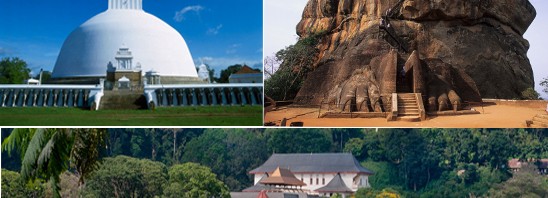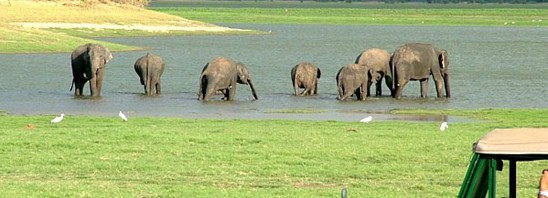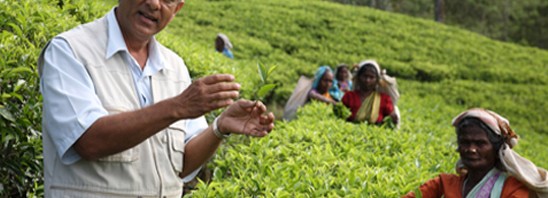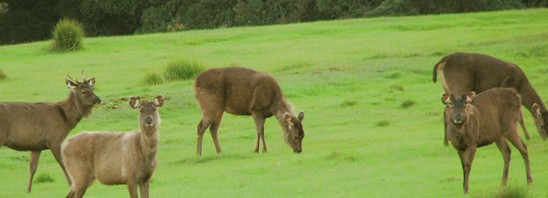Described by Marco Polo as 'the jade of the Indian ocean', the tiny palm-fringed island of Sri Lanka boasts a number of World Heritage Sites and ancient temples filled with mystery. With its rich heritage, plethora of cultural treasures, stunning scenery and incredible wildlife, Sri Lanka offers explorers the chance to venture beyond the irresistible beaches and embark on a journey to discover Sri Lanka’s hidden jewels.
Sri Lanka's Cultural Triangle

The Cultural Triangle has brought Sri Lanka’s history alive in the most enthralling manner for millions of travelers and tells a rich tale of Sri Lanka’s magnificent Royal past. It covers the north central towns of Anuradhapura, Polonnaruwa, Sigiriya, Kandy and Dambulla where extensive archaeological ruins provide a glimpse into the island’s history, dating back to the 4th century B.C. The Cultural Triangle was the cradle of the ancient irrigation civilization of Sri Lanka that flourished 2500 years ago and is a wonderful region to visit with monuments spanning a period of 1700 years. The Triangle is home to five of Sri Lanka's seven UNESCO World Heritage Sites: the cave temples of Dambulla; Sri Lanka's first ancient capital, Anuradhapura (6th –- 10th century); Polonnarawa, the second ancient capital (10th –- 12th century), the Sigiriya rock fortress; and sacred Kandy, the third ancient capital (13th century onwards). The extensive archeological ruins of the Cultural Triangle are now protected by UNESCO as World Heritage sites.
Anuradhapura
At the spiritual heart of the Triangle lies the great ruined city of Anuradhapura - jewel in the crown & capital of the island from the third century BC to 993 AD. This city is one of medieval Asia’s great metropolises, dotted with vast monasteries, elaborate palaces, enormous tanks and a trio of monumental dagobas, excelled in scale in the ancient world only by the Egyptian pyramids. The ruins of Mahavihara, the first monastery, built by King Devanam Piyatissa in 250 B.C.E, and several other monasteries and temples can be seen. Also don’t miss the ancient Bo Tree, which was originally a branch of the Bo tree in Bodh Gaya under which Lord Buddha attained enlightenment.
Sigiriya
A mythical past of feuding dynasties enhances Sigiriya’s striking setting, which was built in 5th century AD by king Kasyapa, as a fortress palace on top of the imposing Sigiriya rock. A UNESCO World Heritage Site, it is also known as Lion Rock because of the huge lion that used to stand at the entrance to the Palace on the summit of the 600-foot rock. Worthy of being called the “8th wonder of the world”, Sigiriya will astonish with its beautiful views, staggering engineering and peerless design. The climb to its summit on metal staircases attached to the rock face is one of Sri Lanka’s most loved experiences. Even those afraid of heights can find enough to marvel at from ground level. At the base of the rock lie the Royal Gardens, which comprised water gardens, a fountain garden, summerhouses and boulder gardens. There are a number of caves as well within the enclosed area and these should not be missed.
Kandy
Kandy which came into existence in the 15th century was the last royal capital where 2500 years of royal rule culminated. Kandy remains an important religious centre of the Sinhalese and a place of pilgrimage for Buddhists, namely those belonging to the Theravada school. Kandy is famed and revered both in Sri Lanka and around the world by Buddhists as the home of The "Temple of the Tooth" and the temple is purported to house one of Buddha's actual teeth. The tooth relic is of great spiritual significance and the Esala Perahera is a must see procession that includes majestically dressed elephants, fire dancers and Kanyan drummers all proudly accompanying a replica of the treasured casket. It was declared a world heritage by the UNESCO in 1988. Another popular attraction in Kandy is the Royal Botanical gardens – home to one of the world’s finest collections of Orchids. The gardens stretch over 60 hectares and feature an arboretum, orchid house and huge colonies of flying foxes.
Yala National Park

Yala National Park is well known for its wildlife preservation in the country and covers an extensive area of 1,259 sq km. The rocky outcrops scattered over the park provides vantage points to enjoy the sprawling areas with Sri Lanka’s dry zone landscape: low scrub and woods. Situated in the south-eastern corner of the island; the park is famous for its high density of leopards (about 35 leopards), perhaps the highest in the world. It is also thought that Sri Lankan leopards are a distinct sub-species from their Indian neighbors, and the largest leopards in Asia. The national park is divided into Yala West (also called Ruhuna) and Yala East. Yala West or Ruhuna National Park is now well recognized for the best park in the world to observe and photograph leopards. It is possible to take one day jeep-safari trip through the park although it takes you three days to see the entire park. Your best chance to see a leopard is generally early in the morning and then again at dusk. You can stay until just after dark inside the park, thus maximizing your chances of a leopard encounter. There is also a substantial elephant population along with spotted deer, Sambar, Wild buffalo, Sloth bear, Jackal, Mongoose, Pangolins and Crocodiles. The bird life comprises over 120 species, and ranges from Lesser Flamingos to Paradise Flycatchers, Crested Hawk Eagles, and Black Bitterns.
Ceylon Tea Trails (Nuwara Eliya)

Sri Lanka is one of the world's largest exporters of tea and some of the world's best tea is produced in this region. Situated approximately 2000 metres above sea level, Nuwara Eliya (meaning “City of Lights”) boasts some of the greenest scenery in Sri Lanka and its tea trails remains the biggest attraction. Recognized as 'Little' England', this former British hill-station was an important centre of Sri Lanka’s tea production in the 19th century. At present, this part of Sri Lanka is entirely tea territory. For many miles prior to reaching Nuwara Eliya from either direction you will find acres and acres of tea plantations, infact nothing but tea estates. There are many factories open for visitors which also have tea sales outlets. So, apart from formal tea factory tours, you can stop anywhere on the hills and walk along the narrow paths of the tea gardens for some great photography. Here you can learn all about the tea-making process, which involves withering, rolling, fermentation, drying, sorting and grading of leaves, when you visit a local tea estate and factory in the surrounding hills. You can also taste a variety of freshly brewed teas, whilst learning how to make that perfect cuppa.
Horton's Plains National Park & World’s End

Horton Plains National Park, a World Heritage Site perched on the southern edge of the Central highlands, midway between Nuwara Eliya & Haputale consists of mountain forests, where the land rises to 2,500 meters above sea-level. The undulating plateau is bounded by the country's second & third highest mountains and is the catchment area for most of its major rivers. Horton Plains became a National Park in 1988 and named after British governor Sir Robert Horton, is a world apart from rest of the tropical island. As an important watershed and catchment for several year-round rivers and streams, the Horton Plains plays host to a wide range of wildlife. The park’s most visible residents are its herds of sambar deer, while you might see rare bear-faced (also known as purple-faced) monkeys.. The relatively cool temperatures of the park, steady precipitation, high altitude, and the convergence of three rivers create a rare and fragile ecosystem in which a unique biosystem flourishes.
World’s End
This is the only national park in Sri Lanka where visitors are permitted to walk on their own (on designated trails only). The cliff plunges at World’s End almost vertically for 700m, creating an astonishing escarpment, revealing breathtaking views across much of the southern area of the island. It's a fairly easy 5 km walk from the main entrance of Horton Plains, through grassland, gentle streams and eventually forest. Wake early for a walk through Horton Plains National Park up to Worlds End to avoid the view being shrouded in mist and don’t forget to pause a while at the 20 m high Bakers Falls, a waterfall formed by the tributary Belihul Oya and named after Sir Samuel Baker, a hunter, explorer & early settler at Nuwara Eliya.
About Odyssey Travels
Odyssey Travels is a leading IATA accredited Travel Company, established in 1992. We specialize in planning customized holidays in India and abroad for our clients which includes air ticketing, worldwide hotel reservations, inclusive tours, sightseeing activities, visa assistance & travel insurance services. For further information or to make a booking contact 020-66442929 or visit http://www.odysseytravels.net/